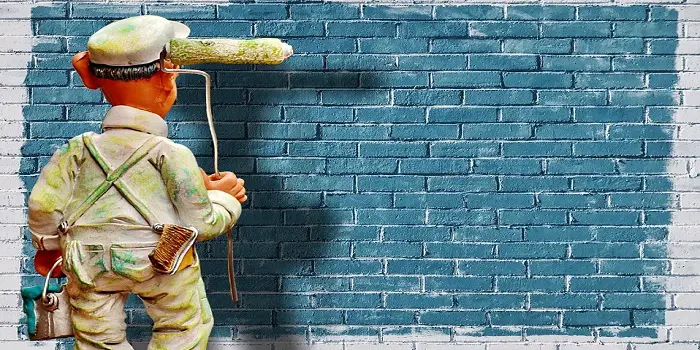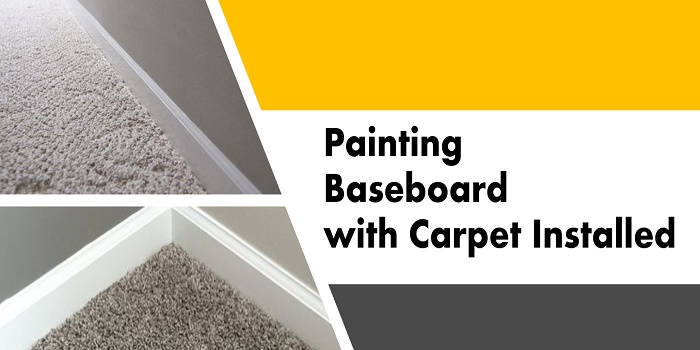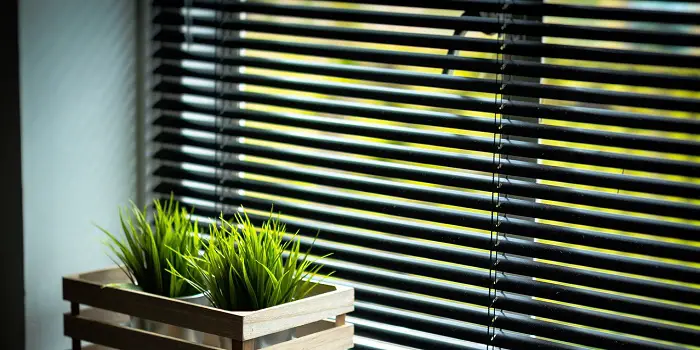
Acoustic ceiling tiles are designed to improve the acoustic environment of a room.
They are placed on the ceiling to help absorb the sound so that it does not bounce off the hard surface and reflect into the room.
The tiles can also be used for soundproofing to help muffle any noise coming from the room and going through the ceiling.
Ceiling tiles can be made from different types of materials.
If your ceiling tiles look drab, a fresh coat of paint may spruce them up at very little cost.
The only caveat is that paint will not work well with ceiling tiles made from fiberglass.
What's Here in the Article:
Steps to Paint Acoustic Ceiling Tiles
The very first step is to choose a type of paint and primer that does not decrease the sound absorption properties of the ceiling tiles.
This rules out regular types of paint and primer. But you can use a water-based, flat-latex type of paint that is formulated to absorb sound.
You should carefully look for the type of paint that does not void the sound-dampening qualities of your acoustic ceiling tiles.
Acoustic-Coat is one brand of paint that is perfect for acoustic ceiling tiles. It has properties that include ceramic microspheres and fillers that absorb sound.
This will increase the noise-blocking properties of the acoustic tiles to an even greater degree.
The next step is to obtain the appropriate painting equipment and covers for the floor and to ventilate the area in which you are going to work.
Now you are ready to paint.
Step 1 – Protect
Cover the surface from which you are going to paint with drop cloths.
Choosing the right cloth for protection is important as it will help protect your floor or table area when you are working on the ceiling.
Step 2 – Remove
Take the ceiling tiles off the grid.
Lift them up individually and gently pull them away from the brackets holding them.
Be careful as you do not want to damage the tile itself.
Step 3 – Clean & Place
Clean the tiles so that there is no dust, and place them on the work surface.
Do not stack them; instead, only take down what you can work on at any time.
Any tile that has been custom shaped for its location needs to be marked so you remember where to put it back.
Step 4 – Paint the Edges
All exposed edges of the tile should be painted using a 2” sash brush.
If the edge is not exposed, then do not bother to paint it.
Step 5 – Use the Roller
Now you are ready to paint the face of each tile.
Pour the paint into the roller pan, and apply the paint to the roller cover, which should have a ¼” to ½” nap.
Press firmly with enough pressure to apply the paint, but not too hard so that you do not crack or break the tiles.
Step 6 – Let the Paint Dry
Allow enough time for the paint to dry fully.
The drying time should be noted on the can or instructions.
This applies to the primer and paints as well. If they need touching up, do so with a brush.
Step 7 – Clean the Brackets & Reinstall
You will need to clean the supporting structure for the tiles in the ceiling.
Use a household cleaner to remove all the dust, then wipe away the residue using a clean cloth or paper towel.
Now you can replace the tiles in the ceiling. Be careful not to chip or scratch the paint.
What are Acoustic Ceiling Tiles Made of?
Acoustic or drop ceiling tiles can be made from several materials.
They are used in studios, schools, office buildings, and basements where the acoustics is poor.
The tiles themselves can be made from one or more of the following materials.
- Fiberglass
- Melamine Acoustic Foam
- Metal
- Mineral Fiber
- Wood
Each type of material brings its own set of advantages and disadvantages.
Knowing what they can and cannot do will help you make the best-informed decisions about which material to choose.
Fiberglass
A highly popular material that has replaced mineral fiber to a certain degree.
They are used frequently in both commercial and residential properties.
Pros: Fiberglass can withstand the elements and resists damage from moisture far better compared to mineral fiber.
Cons: They are still subject to damage from moisture, even if it’s to a lesser degree compared to mineral fiber.
Plus, painting them is out of the question.
Melamine
One of the better options for soundproofing in both residential and commercial applications, melamine has become quite popular in recent years for its advantages.
Pros: Extremely effective in terms of sound reduction, maybe the best on the market.
Cons: They are quite expensive.
So expensive that covering a large area is prohibitive in terms of cost.
Metal
You’ll find metal acoustic tiles in commercial buildings, as they are a higher-end option.
Crafted from metal sheets, they are formed into tiles and often have a pad or blanket added for additional sound absorption.
Pros: They are some of the most effective acoustic tiles on the market, with sound-absorbing properties that are unmatched.
They also come in a wide variety of patterns and finishes, so you can have an aesthetic look you desire.
Cons: They are quite expensive and out of reach for most individuals.
While long-lasting, they are not as cost-effective compared to other materials unless you have a very high budget.
Mineral Fiber
These are arguably the most popular for drop ceiling grids and have been around for a long time.
They are quite effective in terms of absorbing sound and can be mounted easily on the ceiling or walls.
Although other, better sound-absorbing materials have been introduced, mineral fiber maintains its popularity.
Pros: Mineral fiber is affordable and easy to use.
Cons: This substance does not last very long and is a poor choice for areas that are humid or have moisture issues.
Wood
Wood is also a popular choice for acoustic ceiling tiles, as the material is plentiful and inexpensive.
Pros: Strong, sturdy, and long-lasting in cool, dry rooms.
They can also be painted to help them last longer.
Cons: Wood is still subject to damage from moisture, although painting them helps.
Plus, they do not have the noise reduction capabilities of mineral fiber or fiberglass.
Is It Safe to Take the Acoustic Tiles off the Ceiling for Painting?
While acoustic tiles have their advantages, they can also look quite dated, get dirty quite easily, and be difficult to repair.
Plus, certain tile materials such as fiberglass are not possible to paint effectively, which may mean having to replace them, which is more expensive.
Removing the tiles for spray painting may be relatively easy or difficult, depending on how they were attached.
Some tiles are placed into brackets, which makes sliding them out simple.
While others are attached directly to the ceiling, which makes removing them difficult.
The first step is to ensure that removing the tiles is safe.
Asbestos Risk
Until the mid-1980s, asbestos was a popular insulating material because it was fireproof.
However, when it was discovered that long-term asbestos exposure might cause mesothelioma, it was no longer used for commercial and residential properties.
If the ceiling tiles on your property pre-date 1985, then it’s possible they may contain asbestos.
If you suspect that the tiles may contain asbestos, then call your local health department or a building inspector that is experienced with identifying asbestos.
If the tiles do contain asbestos, then you will need to have them professionally removed.
Otherwise, if they do not contain asbestos, you can remove them yourself.
Depending on the condition of the tiles, you can follow these steps…
Glued tiles:
This may be the most difficult type of tile to remove.
It takes time, but it can be done if you cut the tile into sections.
You may need to both pry and scrape, but the tile should come loose.
In fact, if there’s a loose section, that is the best place to start prying them off the ceiling.
Stapled tiles:
You will need a sharp blade or utility knife to cut into the tile.
Cut the tile into sections so you have several small squares.
Pry out each square, starting with the center one.
The squares that have staples will be harder to remove, but with a little prying, they should come loose.
Suspended tiles:
If you have ceiling tiles that are suspended inside a grid structure made from metal or plastic, then removal is fairly simple.
Just push up on each tile until it pops out of the grid.
Then, tilt the tile so it can slide back through the grid and remove it. Repeat for each tile.
How to Install Acoustic Tiles After Painting – How Long Do They Last?
You can either directly attach the tiles to the ceiling or have them installed below the ceiling in a dropped or suspended grid.
For professional applications, hiring professionals is recommended.
But if you want to add a few acoustic ceiling tiles to your home (like in your home theater), then you can do the job yourself.
You can attach the tiles using screws, staples, glue, and even nails, although removing them will be problematic.
A suspended installation is more expensive, but you can remove the tiles easily.
If the tiles are in a cool, dry room, they should last about a decade on average.
After that, the tiles will start to crack and become in need of repair.
Share the post "How to Paint Acoustic Ceiling Tiles – Easy DIY Steps"

Douglas Becker (aka Painter Doug) has over twenty years of experience as a painter in Adkins, Texas. At present, he resides in Florida with his family.
From painting multi-storeyed houses, condos, and apartments to large commercial buildings and small offices, he had served various customers in areas not only in Adkins but also in Southwest Florida, Sarasota, Naples, and many more. To know more about him check here.





